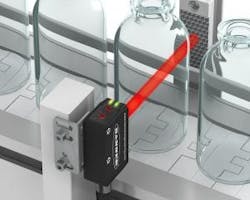Technology Roundup: Machine Vision Insight Aids Operational Oversight
Technology moves fast, and it seems even subject matter experts, aka SMEs, can have trouble keeping up with their subject matter. Machine vision is one such technology that keeps moving ahead—increasing the applications to which it can be applied in pharma, for instance. Those trying to follow along may wish to visit LinkedIn and join in the “Machine Vision in Pharmaceutical Industry” group. It’s small by Internet standards—just 176 members at last count—but has some good discussions, updates on new products, and can be a helpful forum to get your questions answered by, yes, subject matter experts in pharma machine vision.
The group is managed by Kasra Ravanbakhsh, who specializes in machine vision and industrial automation. A couple other LinkedIn groups—“Machine Vision” and “Machine Vision Group”—are oriented towards various industries but are larger and should also be interesting for vision enthusiasts.
What are drug industry end users looking for in their machine vision systems today? One thing is user traceability, says Bob Ochiai of the machine vision group at Keyence. That is, who’s using the system, when are they doing it, and who is authorized to make changes? Keyence has upgraded user functions related to permissions and changes for its XG Series (photo) with more sophisticated User Accounts and Modification Log options, he says.
These changes reflect the increased importance of overall corporate accountability for all systems and processes, Ochiai says. Speed and resolution are also critical needs for end users, he says. Just as consumers of digital cameras and computers are demanding greater camera and processor speeds and higher resolutions, so are drug manufacturers demanding more robust machine vision systems.
Festo is focusing on simplicity and affordability, and yet enhanced functionalities, says Frank Langro, a manager for Marketing and Product Management. Traditional systems with a master controller, sensor interfaces, and various drives often result in complicated and costly systems that place heavy demands on operators, he says. In response, Festo’s compact vision system SBOC-Q utilizes familiar vision tools for parts inspection. These include Blob tools, ROI, and Ray tools. In addition, the vision system supports OCR (optical character recognition) and code scanning for barcodes and data matrix—for monitoring blister packs, bottle caps, and label coding, for example.
In addition to its inspection capabilities, the SBOC-Q has an embedded CoDeSys PLC plus a “CANopen” master interface to increase potential applications. The system can inspect, but also control actuators to reject failing packages, re-orient items such as catheters, or take other physical actions. All necessary information from code reading to OCR can be passed back to a supervisory system via an embedded Ethernet port.
End users have used SBOC-Q to measure the diameter of glass ampoules for conformance to specifications, Langro says. In the same application, the system used backlighting principles to ascertain the presence of printing. For blister checking, the vision system was used to count pills and to assure that there were no empty spots in the pack. If there were empty blisters, the vision system identified the coordinates, made the information accessible to operators, and then withdrew the pack from the line.
In a syringe inspection application, the system was used to identify missing or broken parts such as rubber plunger head, auger flange, thumb rest, and needle hub. A personal care application required the SBOC-Q to check dental floss containers for the presence of the internal roll of dental floss, threads coming out from the correct hole, and threads correctly located on the cutter.
Banner Engineering has added the Q26 Series (photo) to its line of clear object detection sensors. While Banner offers several sensors for reliable clear object detection, the Q26 Series is optimized for the task with its polarized retro coaxial design. The Q26 delivers both the sensitivity required for reliable clear object detection and the robust rejection of light from mirror like objects to prevent a false detection. The coaxial optical design delivers the additional benefit of precise leading edge detection, making it useful for many high speed applications in bottling, pharmaceutical and biopharmaceutical industries. Primary applications are for pharmaceutical vials or bag filling machines, Banner says.
In-Sight Track & Trace (photo) is a new software package for Cognex’ In-Sight vision systems. The software makes it easy for manufacturers to set up a complete identification and data verification solution for package labels, says John Lewis, the company’s market development manager. Customers choose the In-Sight model that best meets the performance and price requirements of their application, and then add software, he says.
One key application is reading an ID code and verifying the accuracy of printed text—for example, date/lot code information. If the label contains GS1 data, In-Sight Track & Trace can verify that the data is formatted correctly, and that it matches the printed text. Mismatched or incorrectly formatted data would indicate a process or database problem demanding immediate attention.
Another key application is that the software can assess the quality of the Data Matrix codes on labels while the system is operating in production mode. This process check helps to make sure that the print quality hasn’t degraded in a way that will cause readability issues downstream, Lewis explains. Equipment can be mounted anywhere on the packaging line—at the item level, carton level, case level, or at the pallet level. According to Lewis, the most strategic area for deployment is actually at the printing or marking station. If a manufacturer is marking bad codes or poor quality text—or worst of all, printing the wrong information—it needs to catch it immediately, before it causes disruptions downstream in the supply chain.
PPT Vision recently agreed to be purchased by data capture and industrial automation firm Datalogic S.p.A., says PPT’s president and CEO Bob Heller. Under the agreement, PPT will continue to operate as a separate company, with headquarters in Minneapolis, and as a center of excellence for machine vision within Italy’s Datalogic. “The partnership provides both organizations with stronger global sales channels, additional product development resources and industry leadership positions in automation and machine vision,” Heller says.
In other machine vision news, Begapt Solutions-India is partnering with Microscan-USA, with an emphasis on solutions such as its Online 2D barcode reading system.









